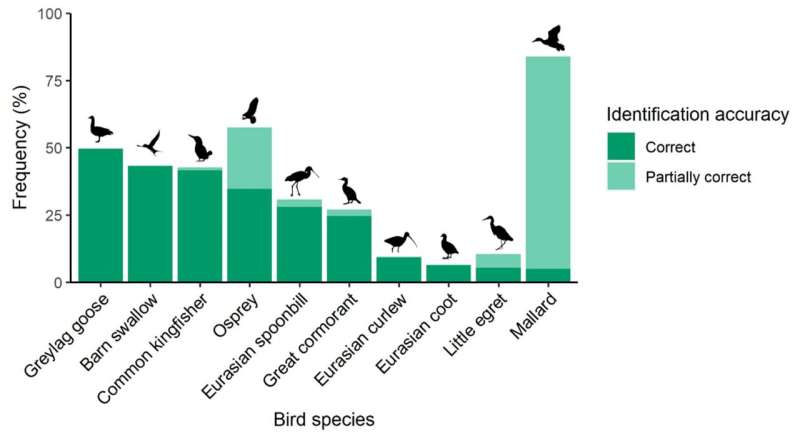This article has been reviewed according to Science X's editorial process and policies. Editors have highlighted the following attributes while ensuring the content's credibility:
fact-checked
peer-reviewed publication
trusted source
proofread
Analysis shows secondary school students have difficulty identifying bird species

The Department of Didactics of Mathematics, Experimental and Social Sciences has analyzed the knowledge of birds of secondary school students, and their attitude towards conservation.
Students have shown that they have scant knowledge about bird migration and species identification, and despite their good environmental attitudes, many consider that conservation efforts are excessive and hamper economic development.
In Western societies, the way nature and the environment are understood is very important, as knowledge of them can influence environmental attitudes. Environmental education is a key tool when it comes to increasing awareness, and a range of programs are offered in both formal and informal settings.
The Urdaibai Bird Center (UBC), located in the heart of the Urdaibai Biosphere Reserve, has numerous habitats necessary for the observation and conservation of migratory birds and is also an ideal location for running environmental education programs.
Although programs to bring biodiversity closer to young people have been run for many years in these settings, their effectiveness has not been evaluated until now.
Based on environmental education programs of this type, researchers from the UPV/EHU's Department of Didactics of Mathematics, Experimental and Social Sciences analyzed the extent to which 908 secondary school students taking part in the Urdaibai Bird Center's activities for a day assimilated what they had seen and learnt. The research is published in the International Journal of Environmental Research and Public Health.
To do this, the students completed a written questionnaire to ascertain their perceptions about the Urdaibai Biosphere Reserve (UBR) and the marshes, their interest in biodiversity, their ability to identify bird species, their knowledge of bird migration, and their attitude towards conservation.
The researcher Unai Ortega emphasized that the main aim of the research was, firstly, to diagnose the students' knowledge and attitudes and, secondly, to evaluate these environmental education programs. "They are very common, but their effectiveness has not been evaluated, so we need to know how well these programs are achieving their objectives," he explained.
The importance of environmental literacy
The researchers found that secondary school students have scant knowledge of biosphere reserves, marshes and bird migration, especially when it comes to identifying bird species. However, despite the high scores in environmental attitudes, many students are of the opinion that conservation efforts in these environments are excessive and hinder economic development.
The results also showed that students from rural areas and those living in or around the Urdaibai Biosphere Reserve know more about local biodiversity, and so do students who in primary school drew up a plan related to birds.
The study concludes that "one-day programs do not affect environmental education," said Ortega. "While useful in promoting environmental knowledge and attitudes in the short term, these programs are of limited effectiveness."
So the researchers pointed out that it might be advisable to adapt the environmental education program of the Urdaibai Bird Center so that it could be included in formal contexts through practical activities or projects, and so that the results could be systematically evaluated. They stressed the importance of continuing to develop "long-term strategies" for systematic evaluations of this type.
Ortega highlighted the importance of emotional attachment in environmental literacy. In his opinion, it is "essential to feel that it is worthwhile caring for what needs to be cared for." In this respect, many of us "have participated in this type of program, but the level of environmental literacy has not increased; on the contrary, the data show that this literacy is on the decline," he pointed out.
More information: Unai Ortega-Lasuen et al, Secondary Students' Knowledge on Birds and Attitudes towards Conservation: Evaluation of an Environmental Education Program, International Journal of Environmental Research and Public Health (2023). DOI: 10.3390/ijerph20105769
Journal information: International Journal of Environmental Research and Public Health
Provided by University of the Basque Country





















